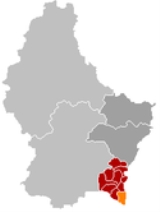
Schengen, Luxembourg
Encyclopedia
Schengen (ˈʃeŋə) is a small wine-making village and commune in far south-eastern Luxembourg
, near the tripoint
where the borders of Germany
, France
, and Luxembourg meet. Other villages within the commune include Remerschen
and Wintrange
. , the village has a population of 1527 with an area of 10.63 km² (4.1 sq mi).
The village became famous on 14 June 1985, when the Schengen Agreement
was signed. To use this name recognition, the council of the commune of Remerschen
decided on 18 January 2006 to rename the commune to Schengen. The Chamber of Deputies
voted on 13 July 2006 a law http://www.legilux.public.lu/leg/a/archives/2006/1503008/1503008.pdf allowing the change of name, which was published on 30 August 2006. The law took effect three days later, and the name of the commune of Remerschen was changed to Schengen as of 3 September 2006.
Schengen Castle
dates from 1390 but was almost completely rebuilt in the 19th century. It is now a hotel and conference centre.
The permanent trilingual permanent exhibition on the history and significance of the Schengen Agreements, on 200 square meters of exhibition space, shows visitors that the elimination of the control of persons at the internal borders put into practice one of the four foundational European freedoms set down in the 1957 Treaty of Rome.
The signing of the Agreement in 1985 exhibited here is documented with historic photos and video and sound footage as well as statements by those involved at the time.
The cornerstone of the European Museum Schengen is an interactive animated map with concise information on the history of the borders of the individual Schengen states as well as other European states that have not yet joined the Schengen Area.
Luxembourg
Luxembourg , officially the Grand Duchy of Luxembourg , is a landlocked country in western Europe, bordered by Belgium, France, and Germany. It has two principal regions: the Oesling in the North as part of the Ardennes massif, and the Gutland in the south...
, near the tripoint
Tripoint
A tripoint, or trijunction , is a geographical point at which the borders of three countries or subnational entities meet....
where the borders of Germany
Germany
Germany , officially the Federal Republic of Germany , is a federal parliamentary republic in Europe. The country consists of 16 states while the capital and largest city is Berlin. Germany covers an area of 357,021 km2 and has a largely temperate seasonal climate...
, France
France
The French Republic , The French Republic , The French Republic , (commonly known as France , is a unitary semi-presidential republic in Western Europe with several overseas territories and islands located on other continents and in the Indian, Pacific, and Atlantic oceans. Metropolitan France...
, and Luxembourg meet. Other villages within the commune include Remerschen
Remerschen
Remerschen is a former commune and small wine-growing town in south-eastern Luxembourg, belonging to the commune of Schengen, near the point where the borders of Germany, France and Luxembourg come together....
and Wintrange
Wintrange
Wintrange is a small town in the commune of Schengen, in south-eastern Luxembourg. , the town has a population of 402. In 2006, the Commune de Remerschen was renamed Commune de Schengen.- Village of Wintrange :...
. , the village has a population of 1527 with an area of 10.63 km² (4.1 sq mi).
The village became famous on 14 June 1985, when the Schengen Agreement
Schengen Agreement
The Schengen Agreement is a treaty signed on 14 June 1985 near the town of Schengen in Luxembourg, between five of the ten member states of the European Economic Community. It was supplemented by the Convention implementing the Schengen Agreement 5 years later...
was signed. To use this name recognition, the council of the commune of Remerschen
Remerschen
Remerschen is a former commune and small wine-growing town in south-eastern Luxembourg, belonging to the commune of Schengen, near the point where the borders of Germany, France and Luxembourg come together....
decided on 18 January 2006 to rename the commune to Schengen. The Chamber of Deputies
Chamber of Deputies of Luxembourg
The Chamber of Deputies , abbreviated to the Chamber, is the unicameral national legislature of Luxembourg. 'Krautmaart' is sometimes used as a metonym for the Chamber, after the square on which the Hôtel de la Chambre is located....
voted on 13 July 2006 a law http://www.legilux.public.lu/leg/a/archives/2006/1503008/1503008.pdf allowing the change of name, which was published on 30 August 2006. The law took effect three days later, and the name of the commune of Remerschen was changed to Schengen as of 3 September 2006.
Schengen Castle
Schengen Castle
Schengen Castle is located in the village of Schengen in the south-east of Luxembourg close to the borders with France and Germany. Dating from 1390 but almost completely rebuilt in the 19th century, it is now a hotel and conference centre.-History:...
dates from 1390 but was almost completely rebuilt in the 19th century. It is now a hotel and conference centre.
The European Museum in Schengen
The European Museum was opened on the 13 June 2010, 25 years after the signung of the Schengen Treaty, in the building "Centre Européen".The permanent trilingual permanent exhibition on the history and significance of the Schengen Agreements, on 200 square meters of exhibition space, shows visitors that the elimination of the control of persons at the internal borders put into practice one of the four foundational European freedoms set down in the 1957 Treaty of Rome.
The signing of the Agreement in 1985 exhibited here is documented with historic photos and video and sound footage as well as statements by those involved at the time.
The cornerstone of the European Museum Schengen is an interactive animated map with concise information on the history of the borders of the individual Schengen states as well as other European states that have not yet joined the Schengen Area.

